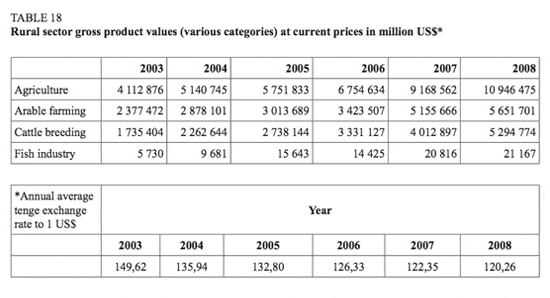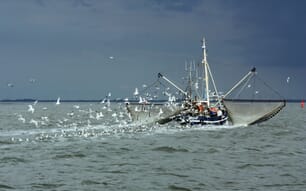According to the Fisheries Committee of Kazakhstan, 17,300 people were employed within the fisheries sector in 2006, a figure that is sharply down from the 1980s when the sector employed around 60,000, but up from the official figure of 2002 when there were only 13,200 persons working in the sector.
But there is some dispute with the actual numbers. As mentioned earlier, the majority of catches are not registered, and a signifi cant part of fishery activity is in the black economy and hence not refl ected in the official reporting (statistics). While the 2004 FAO Fisheries profile put the number employed at less than a third of the Fisheries Committee figure (5 200 persons), the World Bank (2005) suggests that as many as 110 000 rural residents may be (informally) active in the sector – where fishing is an alternative source for livelihood and an important supplementary source of animal protein in the diet of rural workers during the winter. The World Bank used the data provided by the Researcher Group Fishery Sector, which also concluded that actual catches are three to four times higher than those officially declared. Timirkhanov et al. (2007: 51) in fact postulate that as many as 300 000 people nationwide may be dependent upon fisheries for their livelihoods. The latest figures from the Agency of the Republic of Kazakhstan on Statistics (2008) estimate the number of employees in fisheries and aquaculture at only 2349 with an average monthly nominal wage of tenge 50223 (i.e. about US$418).
Most people employed in the sector are hired under seasonal contracts and, in summertime, as the levels of catch decline, many factory floor employees in fish processing plants are made redundant for a period of two to three months. Fishers hired under such contracts are obliged to seek alternative livelihoods during this period. In addition, current laws and regulations are such that fishery sector employers are not eager to report on all employees (including seasonal workers)involved in their fishing business. There are no disaggregated data available to show numbers employed by oblast, by company or by sector (aquaculture or capture, private or public).
Kazakhstan does not have specific social security schemes for fishers. However, fishers, like all Kazakh citizens, are entitled to a variety of child benefi ts and income support schemes when income falls below a defined level. A fisher in Karateren, for example, was receiving around tenge 10000 a month – a useful supplement to his fishing income, which was barely double that sum (Thorpe and van Anrooy, 2009).
Decree No. 30-3 of 7 February 2005 “About Obligatory Insurance of the Civil Liability of the Employer for Causing Any Harm to Life/Health of the Worker during the Execution of Their Labour Duties,” (Article 3 – civil liability of the employer), establishes that an employer has a duty of care to the employee in the workplace and can be held liable in the case of an accident occurring. However, few fishers had contracts which entitle them to such support – and most fishers are responsible for ensuring their safety on board their vessel (only a few fishers have safety equipment such as life jackets or life buoys due to their cost).
While official catch estimates put the sectoral share at 0.2 per cent of GDP, if the illicit catch is factored in the share could be as much as 0.75 per cent of GDP. This moreover is likely to increase following substantive state and private sector investment in restocking. While aggregate data are not available for private sector investment, state financing of hatcheries and nurseries increased 65 per cent between 2004 and 2007, from tenge 246.5 million to tenge 406.3 million (around US$3.38 million).
Figures from the Agency of the Republic of Kazakhstan on Statistics (Table 19) show that the contribution of fisheries to the GDP increased significantly between 2003 and 2008, as it had increased 3.7 times. This increase can partly be attributed to the State Programme on Fish Industry Development (2004– 2006). However, the share of the sector in the total rural sector’s contribution to the GDP is still minimal. Agriculture and cattle breeding are not signifi cant (in agriculture in 2008 it was about 0.2 per cent, in cattle breeding 0.4 per cent; see Table 19).


To further facilitate the reactivation of the sector, the Government of Kazakhstan has signed 35 agreements with other states (a further 14 are under negotiation) on double taxation relief so as to encourage inward investment into the sector. Currently, resource users are subject to the following taxes or levies:
- Payments for bioresources, approved by the Government of Kazakhstan. These are quota fees for corporations
- Social tax (depends on status of the resource user) for corporations
- Personal income tax for individuals (varies according to income of the person)
- Pension tax for individuals (10 per cent of income)
- Corporate tax (20 per cent of income), for corporations only
- Wealth tax (0.1 per cent of income) for corporations
- Land and water taxes (fixed fee, depending on area/volume used) for corporations
- Environmental tax (if harmful substances employed) for corporations
- Transport tax (depends on mode of transport and age of vehicle) for corporations
- VAT (12 per cent of sales) for corporations
Small businesses also benefit from a Special Tax Mode (STM) – introduced to prevent them from crossing the boundary from licit to illicit production, which simplifies reporting procedures and also entitles such enterprises to pay reduced levels of tax. Significant tax privileges are also available under the STM for agricultural production, with a halving of all the taxes identified above. Peasant farmers also make a single land tax payment, dependent on the size of the landholding.
Fishers and fish processors are currently not party to the STM and so are unable to benefit from reduced tax burdens. Yet given that most fisheries enterprises have less than 50 employees (qualifying them as a small business on the above staffing criteria – many in fact are simply owner-fishers), and that the majority are employed on a seasonal basis, the current tax burden is not simply inequitable, but is also a disguised incentive to under-report catches. In accordance with the Law # 2 42 from 21.01.2010 “About modification and additions in some acts of the Republic Kazakhstan concerning the fish economy” many changes were added into the following legal documents:
In accordance with the Law # 242 from 21.01.2010 “About modification and additions in some acts of the Republic Kazakhstan concerning the fish economy” many changes were added into the following legal documents:
- The law of Republic Kazakhstan from July, 9th, 2004 593-II About protection, reproduction and use of fauna.
- The Criminal code of Republic Kazakhstan from July, 16th, 1997.
- The code of administrative offences of Republic Kazakhstan Code from January, 30th, 2001
- The Water code of Republic Kazakhstan from July, 9th, 2003
- The Ecological code of Republic Kazakhstan from January, 9th, 2007
- The Law of Republic Kazakhstan from July, 8th, 2005 “About state regulation of development of agriculture and rural territories”
- The law of Republic Kazakhstan from November, 16th, 2009 “About modification and additions in some acts of Republic Kazakhstan concerning the taxation”
- In the Law of Republic Kazakhstan from July, 7th, 2006 “About especially protected natural territories”
All these changes concerned mainly the aquaculture sector. In particular, these changes involve the provision of subsidies for fish feed purchase (50 per cent), for buying fingerlings (50 per cent) and for genetics and breeding of fish (50 per cent). The aim was to increase the efficiency and quality of production of aquaculture by providing budgetary support for leasing of equipment and gears for fishing, for artifi cial reproduction of fish and for processing and production. The amendments to the tax code will reduce the sum of corporate surtax by 70 per cent, including changes to the value added tax, the social tax, the land tax, the property tax and the tax on vehicles.
Credit and investment in fisheries and aquacultureUnder the Innovative Industrial Development Strategy of the Republic of Kazakhstan for 2003–2015, the joint-stock company “National Holding KazAgro” is mandated to offer financial support programmes for various branches of agricultural activity through a series of joint-stock companies7 – however, it does not have a specialized programme to support the fisheries sector.
While the country’s commercial and state supported banks are willing to extend credit at interest rates of 11 per cent p.a. (or above), small and medium-sized fishing enterprises are largely precluded from accessing credit due to their lack of collateral and the low levels of recorded catch. Small- and medium- scale enterprises in the fishery and aquaculture sector in Kazakhstan generally do not have access to microcredit nor to microfi nance services. Insurance of the aquaculture production processes is not possible at the present time.
Currently, just the Investment Fund of Kazakhstan (IFK) is funding (two) fisheries projects:
- The Modernization and Extension of Fish Processing Industries Project in East-Kazakhstan oblast (Borrower: the joint-stock company Zaisan Fish Products).
- The Organization of Fish Processing project centred upon the factory in Almaty oblast (Borrower: the joint-stock company White Fish of Kazakhstan).
The sums that are loaned are not public knowledge. The World Bank investment project “Syr Darya Control and Northern Aral Sea Project” (SINAS), which was executed in the period 2001–2008, resulted in a reduction of salinity in the North Aral Sea, and enabled fish catches to rise from 52 tonnes in 2004 to more than 2 000 tonnes in 2007. Two fish processing plants and three fish receiving centres were fully operational by the end of 2008 (World Bank, 2008). The second phase of the SINAS project is likely to include additional activities in support of the fishery sector rehabilitation and development in the North Aral Sea.
The role of fisheries and aquaculture in food security and poverty alleviationThere is a paucity of data on poverty in the Republic of Kazakhstan. Thorpe and van Anrooy (2009) note however that poverty has only increased marginally since the break up of the Soviet Union (up from 15.5 per cent of the population in 1989 to 21 per cent in 2003). Declining life expectancy accounts for the country slipping from 54th to 73rd on the Human Development Index in the period 1990–2005 (down 2.9 years to 65.9 years in this same period). Poverty is most acute in the 50–60 “sick” towns which saw their principal enterprise (and main employer) close during the independence period, and which prompted the approval of the 2002 law “On Targeted Social Assistance”, a programme that provides assistance to an estimated 90.4 per cent of the people who fall below the national poverty line.
While the country does not produce a poverty reduction strategy paper, the “2003–2005 State Program for Poverty Reduction in the Republic of Kazakhstan”8 noted extensive and acute levels of rural poverty, which was territorially concentrated in Atyrau and Mangistau oblasts bordering the Caspian Sea (poverty levels in the more remote areas of Mangistau reaching 95.5 per cent). In response, the programme promised to reduce poverty by 48.8 per cent between 2002 and 2005, with food security being one of its main objectives – although the role that the fisheries and aquaculture sector would play in this strategy was not defined.
At the household level, however, fish and fish products can provide an important livelihoods component with an estimated 300 000 dependent upon income and/or protein derived from the sector. Among approximately 150 fishing communities across Kazakhstan, practically every household possesses some form of fishing tackle, and recreational/subsistence fishing is often undertaken to supplement the household diet. Fishing is a particularly important source of protein in the winter months when farming and many other activities are well-nigh impossible.

